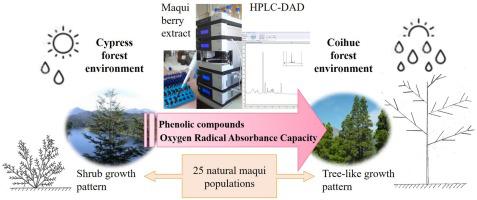Journal of Applied Research on Medicinal and Aromatic Plants ( IF 3.8 ) Pub Date : 2021-08-21 , DOI: 10.1016/j.jarmap.2021.100341 Cecilia S. Roldán 1 , Gonzalo Caballé 1 , Ariel Fontana 2, 3 , Maximiliano Viale 4 , Federico Berli 2, 3

|
Maqui (Aristotelia chilensis [Mol.] Stuntz) is a native berry of the Patagonia Andean forests, which has one of the highest antioxidant levels currently known. This biochemical characteristic strongly depends on the phenolic profile and is highly influenced by the growing environment. The objective of this study was to characterize natural maqui populations in the immediate lee (Argentina) of the Northern Patagonian Andes, distributed in a latitudinal gradient and associated with coihue (Nothofagus dombeyi) and cypress (Austrocedrus chilensis) forests, humid and xeric environments, respectively. Twenty-five natural populations that spanned the geographical distribution of the species in Argentina, were identified. The sites were associated with two forests (coihue and cypress) and three latitudinal groups (north, center and south). Canopy cover and light interception were measured in the selected sites, as well as plant morphology, fruit yield components, phenolic profiles and oxygen radical absorbance capacity (ORAC) of mature berries. Maqui populations associated to cypress are exposed to greater incident total solar radiation and lesser rainfalls, and showed shorter plants with several main stems, multiple branching and smaller specific leaf area (SLA) as compared to those of coihue forest. Maqui populations associated to coihue presented an increase in the number of berries per bunch, and also in the accumulation of phenols and ORAC. The evaluation of the acclimation responses of the natural populations by different environments can contribute to the development of high-yield and quality maqui crops as source of bioactive compounds.
中文翻译:

Maqui (Aristotelia chilensis [Mol.] Stuntz) 与阿根廷巴塔哥尼亚自然种群森林类型和纬度梯度相关的形态和酚类特征
Maqui ( Aristotelia chilensis [Mol.] Stuntz) 是巴塔哥尼亚安第斯森林的原生浆果,是目前已知的抗氧化水平最高的浆果之一。这种生化特性在很大程度上取决于酚类成分,并且受生长环境的影响很大。这项研究的目的是描述北巴塔哥尼亚安第斯山脉紧邻背风(阿根廷)的自然马基种群,这些种群分布在纬度梯度上,并与coihue ( Nothofagus dombeyi ) 和柏树 ( Austrocedrus chilensis ) 相关。) 森林、潮湿和干旱的环境,分别。确定了跨越阿根廷物种地理分布的 25 个自然种群。这些地点与两个森林(coihue 和柏树)和三个纬度组(北部、中部和南部)有关。测量了选定地点的冠层盖度和光拦截,以及成熟浆果的植物形态、果实产量成分、酚类成分和氧自由基吸收能力 (ORAC)。与柏树相关的 Maqui 种群暴露于更大的入射总太阳辐射和更少的降雨量,与 Coihue 森林相比,它们的植物更短,具有几个主茎、多分枝和更小的比叶面积 (SLA)。与 coihue 相关的 Maqui 种群呈现出每束浆果数量的增加,以及酚类和 ORAC 的积累。评估不同环境下自然种群的适应反应有助于开发高产优质马基作物作为生物活性化合物的来源。










































 京公网安备 11010802027423号
京公网安备 11010802027423号